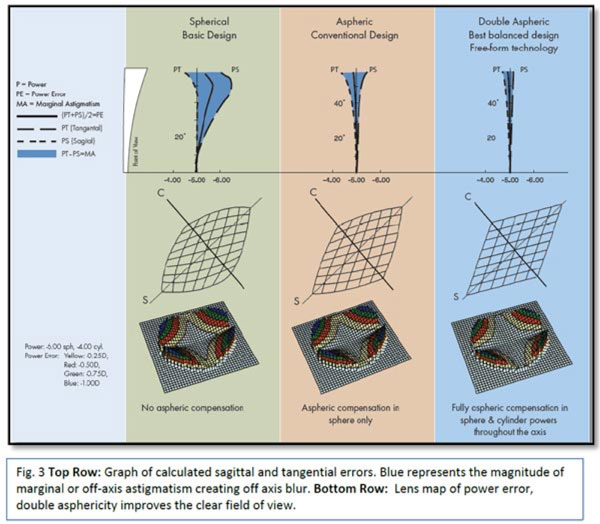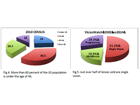In part one of this series we began to examine and discuss asphericity, dual asphericity, atoricity and Free-form as better choices for a clearer field of vision in single vision lenses. Each provides an improvement in the way that a patient sees.
The amount of asphericity needed in each meridian of a lens is determined by calculating the improvement of the errors that affect vision. For example, marginal astigmatism (off center errors) causes peripheral blur, increasing as the eye turns and the angle between the lens surface and the eye changes. To illustrate this, maps of the astigmatism can be created using various surface designs. The difference between the horizontal and vertical errors (sagittal and tangential) is the marginal astigmatism.
In Fig. 3, the top row describes the errors that combine to create marginal astigmatism (blur). The first is a standard toric lens, next a simple front surface aspheric, the third a Free-form double aspheric. The blue color, used to fill in the difference between the sagittal and tangential lens errors (errors in the two principle meridians of a lens -6.00D sphere power with a -4.00 D cylinder) represent the amount of blur (marginal astigmatism) away from lens center. Asphericity reduces blur, while double asphericity reduces it further. The graph suggests that out to 60 degrees or about 30mm, there is little variation in lens power.

As you can see, the errors can be significantly reduced using double asphericity. This results in an improvement to the clear field of view. As a result, lenses, even in large sizes return better optics. The middle row shows that there is also reduced distortion.
The bottom row of Fig. 3 illustrates the application of correcting the lens surface for power error and the resulting the size of the clear field of view. As you can see, reducing the power errors increases the clear field of view in both meridians of power. A power error map illustrates each of the lens forms, spherical, aspheric and double aspheric design.
These lenses use the default or average fitting characteristics of tilt, wrap and vertex distance. Of course, as you learned in progressive lens fitting, decreasing the vertex distance also makes the size of the clear field larger (keyhole effect).
Now, take the calculations of full lens prescription requirements (their surfaces) to their logical next step considering lens tilt and the lens can be further improved. Lens tilt affects the delivery of the lens' power as the eyes saccade normally i.e., scan the field of view. Input that information and using Free-form surfacing, improve the prescription everywhere on the lens when lenses are worn differently than average. Review the bottom row of Fig. 1. It describes the two methods of improving vision in all prescriptions with spectacle lenses while flattening also improves looks.
This single vision lens improvement is so good that it now competes for the contact lens wearer. For a long time, contact lens wearers saw better through their contact lenses than spectacles. That was because the off-axis blur in a cylinder spectacle prescription was significant in comparison to the tear film correction provided by a gas permeable contact lens. In addition, the contact lens center moved with the eye. However, with the popularity of soft contact lenses, in a patient population with cylinder correction between 0.75D and 1.50D, an optimized or a customized Free-form SV lens will actually deliver better vision. If that makes a difference to the wearer, then spectacles become a better solution. The spectacles will be worn more waking hours and the patient actually cares more about the way that the frame looks. As a result, these patients purchase frames based on the usual drivers i.e., trends, brand, style, color and demographics rather than cheap glasses, just to wear with their pajamas.

Mark Mattison-Shupnick, ABOM, is currently director of education for Jobson Medical Information LLC, has more than 40 years of experience as an optician, was senior staff member of SOLA International and is a frequent lecturer and trainer.












